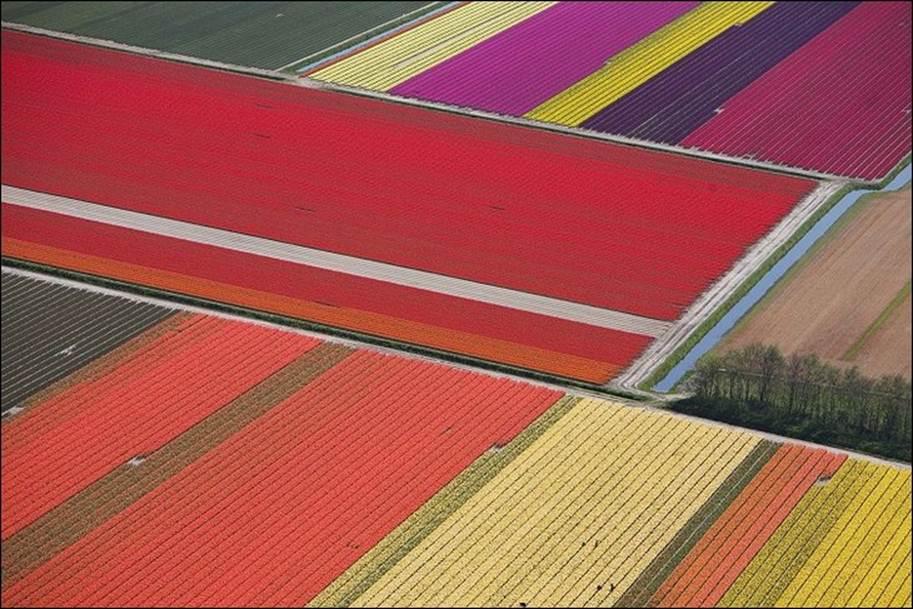Tis the season to be planning your spring bulb display (that is if you are in the northern hemisphere). I know this picture circulates the internet every spring, but now (in the fall – before the ground freezes) is really the time to think about bulbs if you want to create something really interesting.

The Problem with Forced Bulbs
If you wait until the spring, you will only have the option of planting forced bulbs. Forced bulbs is the term we use to talk about bulbs that are blooming irregularly. The natural cycle of a bulb requires that it get some length of time (typically at least 8-16 weeks, depending on the bulb) at temps between 35 and 45 deg F.
In the wild (in this case, wild can actually include your garden) this is taken care of when winter comes, the foliage has died back and the bulb retreats into itself until the warmer temperatures of spring entice it to begin new bloom cycle. But with forced bulbs, we take the nature part out.
Forcing means that the bulbs bulbs are not planted in the ground all year. They do not have their needs for chilling and warming and light and environmental controls taken care of by the sun, the seasons, and the soil around them. Forcing means they have been chilled without the assistance of natural winter – and we have replaced that process by human hand and with manufactured refrigeration.
Forcing is a horticultural techniqure that is entirely ok for a gardener to employ if you didn’t get those last few bags into the ground before the snow came. Pack the bulbs in something that will prevent them from drying out, and pop them into the crisper drawer. Plant them up later when the soil warms back up. It is ok – but on commercial and industrial level – forcing bulbs is too taxing and it isn’t something we should be doing.
Key Factors in the Environmental Cost of Forced Bulbs
Forced bulbs come at a huge environmental cost – and when you see them in the market, you really ought to think twice about encouraging their production.
- Refrigeration Energy Usage
- Forced bulbs require a cold period (vernalization) to mimic winter, often achieved in climate-controlled refrigeration units.
- Environmental Impact: Refrigeration consumes significant amounts of electricity. According to studies, commercial refrigerators can consume 800-1,200 kWh/year, and large-scale refrigeration for forcing bulbs can result in substantial greenhouse gas emissions depending on the energy source.
- Labor and Transportation
- Bulbs for forcing are often shipped multiple times: from growers to cooling facilities, then to distribution centers, and finally to retail or consumers.
- Environmental Impact: Transportation contributes to carbon emissions, especially if air freight is used. Additional labor costs also increase the energy footprint for handling and packaging.
- Substrate Preparation and Soil Use
- Forced bulbs are typically grown in pots or trays filled with imported growing media (like peat or coir), which often requires harvesting, processing, and transportation.
- Environmental Impact: Harvesting peat, in particular, is highly carbon-intensive and depletes critical carbon-storing ecosystems.
- Discarded Bulbs
- Many forced bulbs are discarded after flowering because they are too depleted to regrow without special care.
- Environmental Impact: This creates waste and adds to the unsustainable production cycle, as these bulbs often aren’t composted but sent to landfills.
- Greenhouse Heating and Lighting
- Forcing bulbs often occurs in heated greenhouses that may require additional lighting to optimize growth.
- Environmental Impact: Heating and artificial lighting are energy-intensive, especially if the greenhouse relies on fossil fuels.
The carbon footprint of forced bulbs could be 2-5 times higher than naturally planted bulbs. This estimate is based on:
- Refrigeration energy use (up to 0.1-0.2 kg CO₂ per bulb for 12-15 weeks of chilling).
- Additional transportation emissions (up to 0.05 kg CO₂ per bulb).
- Heating and lighting in greenhouses (variable but can be significant).
Comparatively, naturally planted bulbs primarily have a footprint from their initial production and transportation, estimated at 0.1-0.3 kg CO₂ per bulb for those planted directly into a garden.
Surprise! Mass Production Gives You Boring Ubiquity
Forced Bulbs (i.e. those that are available for installation in the spring, ready to bloom when you want them) are only available in very limited varieties, and on top of being an environmental disaster – the effort is made by growers only for the most basic of colors and varieties. Buying forced bulbs is a surefire recipe for having a display that is literally nothing special.
If you use forced bulbs in your garden – all you can have is a standard display of basic yellow daffodils, red or yellow tulips, and typically some grape hyacinths. The millions of beautiful bulbs, in a vast range of colors, shapes and sizes, are ignored by the forcing world – the only way to have something less basic is to plant bulbs in the fall and wait for nature to take its course. You have to have the foresight and patience to do something in the fall and know that you won’t see the results for at least 4 months.
Forced bulbs are a short-sighted way that many commercial properties use to get annual spring bulb displays — and it really is costing us (both in cash and resources).
But if you want to be unique and special then you need to step back and think about planting a better variety in the fall. This is especially important to think about if you are managing a hotel, spa or other hospitality property.
I implore you to stop the environmental madness – and get creative in the fall. Plant bulbs when they are meant to be planted and stop buying forced bulbs in quantity. Let your imagination soar with varieties and colors, while saving money and acting responsibly.













:max_bytes(150000):strip_icc()/zoekravitz3-ec04198f4ecf4e468b35f075d4f9c51d.png?w=1300&resize=1300,800&ssl=1)